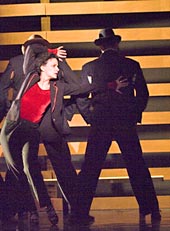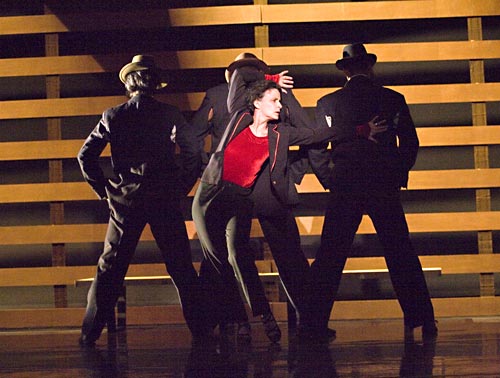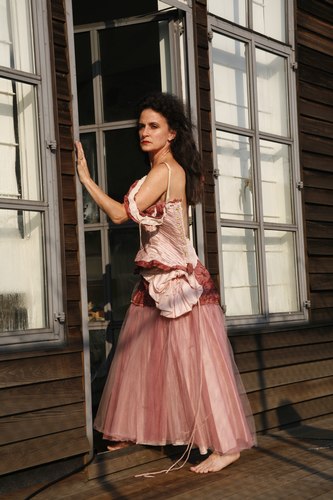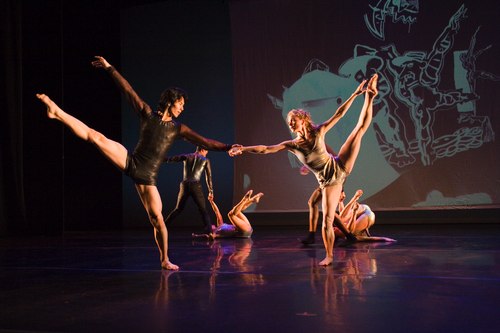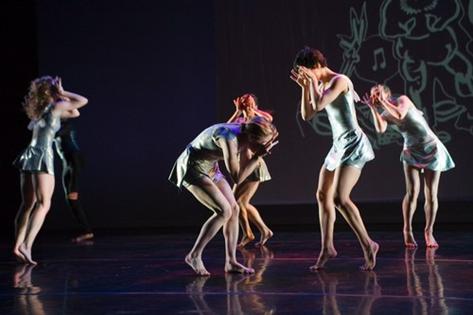![]()
March 15, 2007 , Excerpted Reviews
Dance Review | Buglisi Dance Theater
By JENNIFER DUNNING
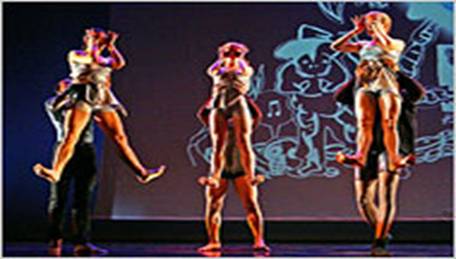
Andrea MohinAndrea Mohin/ The New York Times
Jacqulyn Buglisi and her dances were the heart of Buglisi Foreman Dance, now Buglisi Dance Theatre .
In her years with the Martha Graham Dance Company, which she joined in 1977, Ms. Buglisi performed with a vivid extra spark that has also informed her choreography. Neither she nor Donlin Foreman, a Graham dancer who was a founder of the original company, has been afraid of larger-than-life Graham-style passion and handsome production values. And Ms. Buglisi has always been full of intriguing ideas about dance themes.
…The evening got off to a magisterial start with Ms. Buglisi’s1998 “Against All Odds (Quand Même),” a star turn for the former Graham principal Terese Capucilli that was inspired by Sarah Bernhardt and is set to swelling Rachmaninoff. But who needs Bernhardt when Ms. Capucilli is around to chew up scenery in grand diva style, in over-the-top performing that is filled with minute dynamic and emotional shifts and nuances…
Ms. Buglisi’s 2001 “Sand” proved that she has a strong sense of craft. Dancers were moved around the stage fluidly, flowering into potent momentary images... The piece was also a good introduction to the technical skills and the dramatic commitment of the Buglisi dancers, particularly the febrile Helen Hansen and the imposing La Michael Leonard Jr. “Acapelorus (A Walrus Tale),” described in the program notes as a dance opera and “a poem of compassion for peace.” …was a musical score by Libby Larsen, performed live by the Cassatt String Quartet…Tucked into that score were texts by Lewis Carroll and Gregory Orr, spoken by Christine Dakin and Olive Numeroff and sung by Ximena Borges. A video served as set, depicting a hand drawing a picture by Michael Arthur in which a Carroellian flying pig could be detected. ...There were standout moments… running jumps for Marie Zvosec with feet churning in midair. At the end, the nine dancers looked at the completed drawing as if they were trying to figure out how to enter it, like Alice and her looking glass.
…Ms. Buglisi’s new “Caravaggio Meets Hopper” Set to a “music soundscape,” scores by Nino Rota, Jelly Roll Morton and John Corigliano, the group piece was mostly a matter of seamless gatherings and dispersals in a slatted, chair-filled set by Jack Mehler... including a quietly resonant Martine van Hamel and Robert La Fosseas the lovers, a jazz-strutting Ms. Dakin and Ms. Capucilli…
Buglisi Dance Theater Premieres Two Ambitious
Works
By FREDERICK M. WINSHIP
NEW YORK, March 14 (UPI)- Jacqulyn Buglisi, one of America’s most talented modern dance choreographers, has created two new ambitious works for performance by her company, Buglisi Dance Theater, during its current engagement at the Joyce Theater running through Sunday.
The 13-year-old company, formerly known as Buglisi Foreman Dance, consists of 13 dancers including several formerly associated with the Martha Graham Dance Company of which Buglisi herself was a principal dancer. Her choreography reflects the Graham dancing style and preference for theatrical staging but in general reflects Buglisi’s own individual idiom that is passionate, dynamic, and often thrilling.
The most rewarding and innovative of the works that received their world premiere Tuesday is “Caravaggio Meets Hopper” that is billed …“a study in contrasts…amplifying the hyper theatrical line of (Michelangelo) Caravaggio and the phlegmatic stillness of (Edward) Hopper.” There is little of these two disparate artists reflected in the work, so forget the choreographer’s hype.
What we have here is a sprightly, never phlegmatic dance number for 11 of the company’s dancers performed in dance slippers to a recorded “music soundscape” including snippets from scores by Nino Rota, Jelly Roll Morton, and John Corigliano. It is danced before a backdrop of black slats against a white background devised by Jack Mehler, and at times the dancers wear clip-on white grillwork masks for no apparent reason. Costumes by A. Christina Giannini strike a 1940s note with lots of fedora hats for the men and a red straw hat for one of the women.
Indeed, “Caravaggio Meets Hopper” relates more to the Hopper era of film culture (the artist did use the movie theater several times as a setting) than to any aspect of the Caravaggio’s more formal Renaissance world. Among the sung and spoken sound clips is a “ Casablanca” quote from Humphrey Bogart ending in the familiar “Here’s looking at you, Kid.” There are also chairs and a bench on the stage moved about to suggest a movie theater or even a railway station, challenging the audience’s imagination.
The choreography itself is a delightful mix of group gatherings, scatterings, and occasional solo movement, some of it joyous, much of it searching and wistful as is the case of a passage given to one of the company’s most expressive dancers, Andrea Miller. The focus is at times on two lovers danced by guest artist Martine Van Hamel and Robert La Fosse, former principle dancers with American Ballet Theater, to heart-tugging effect.
Also in the cast were Christine Dakin and Terese Capucilli, former co-artistic directors of the Martha Graham Dance Company, dancing featured roles but pretty much blending in with the ensemble that cannot be flawed for its nimble, often jazzy performance that leaves a strong impression despite the lack of focus or meaning from which this ineptly titled work suffers. “Caravaggio Meets Hopper” would make more sense as an unapologetic riff on the jazz era.
The other new, successful Buglisi work is titled, “Acapelorus (A Walrus Tale),” a variation on Lewis Carroll’s “Looking Glass” stories. There is so much business going on in this number that it distracts from the dancing, which again is first rate. There is a giant screen on stage on which is projected the image of an artist working on a stick figure drawing of Carroll characters, Christine Dakin and Olive Numeroff reading poetry including an excerpt from “The Walrus and the Carpenter,” and live music by the spotlighted Cassatt String Quartet with soprano Ximena Borges singing.
Danced to a Libby Larsen musical score , the diffuse…work for nine dancers, billed as “a poem of compassion for peace,” passes quickly enough without leaving any strong impression except for some bizarre running, jumping steps performed by Marie Zvosec, some extraordinary footwork by Junichi Fukuda, and amusing, awkward appearing lifts. The work was danced barefoot as were the two other works on the program.
One of them, a solo work titled, “Against All Odds (Quand Meme),” was danced with virtuoso intensity by Terese Capucilli, playing the great 20th century actress Sarah Bernhardt whose personal motto was “Quand Meme.” Dressed in an Edwardian costume and wearing an ankle bracelet, Capucilli ran through the gamut of emotion demanded by the various highly dramatic roles Bernhardt played and danced with diva flourishes to a recording of Sergei Rachmaninoff’s soaring Piano concerto No. 1. The work even includes a recording of Bernhardt’s voice.
The other work, aptly titled “Sand,” is an all-tan production designed by Jacobo Borges and danced to a wonderfully melodic score by Phillip Glassperformed live by the Cassatt String Quartet and punctuated by wind and rain sound effects.
It is a showcase for Buglisi’s skill as a choreographer and the technical prowess of the company dancers, six of whom garbed in sand-colored costumes dance the work as three couples- Helen Hansen and LaMichael Leonard Jr., Marie Zvosec and Junichi Fukuda, Andrea Miller and Sean Scantlebury. The motion in this work is poetically fluent.
Home | About
Us | Upcoming Performances |
Recent Publicity & Reviews
Teaching & Performance | Support
Us | New York Seasons | Photos

